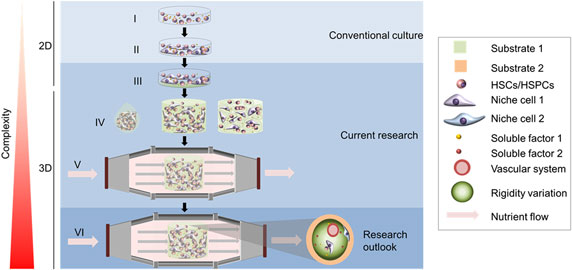Crossref Citations
This article has been cited by the following publications. This list is generated based on data provided by
Crossref.
Ribeiro-Filho, Antonio Carlos
Levy, Débora
Ruiz, Jorge Luis Maria
Mantovani, Marluce da Cunha
and
Bydlowski, Sérgio Paulo
2019.
Traditional and Advanced Cell Cultures in Hematopoietic Stem Cell Studies.
Cells,
Vol. 8,
Issue. 12,
p.
1628.
Severn, C.E.
Eissa, A.M.
Langford, C.R.
Parker, A.
Walker, M.
Dobbe, J.G.G.
Streekstra, G.J.
Cameron, N.R.
and
Toye, A.M.
2019.
Ex vivo culture of adult CD34+ stem cells using functional highly porous polymer scaffolds to establish biomimicry of the bone marrow niche.
Biomaterials,
Vol. 225,
Issue. ,
p.
119533.
Essawy, Mohamed
Abdelfattah-Hassan, Ahmed
Radwan, Eman
Abdelhai, Mostafa F.
Elshaboury, S.
and
El-Badri, Nagwa
2020.
Regenerative Medicine and Stem Cell Biology.
p.
67.
Cucchi, D.G.J.
Groen, R.W.J.
Janssen, J.J.W.M.
and
Cloos, J.
2020.
Ex vivo cultures and drug testing of primary acute myeloid leukemia samples: Current techniques and implications for experimental design and outcome.
Drug Resistance Updates,
Vol. 53,
Issue. ,
p.
100730.
Abbonante, Vittorio
Di Buduo, Christian A.
Malara, Alessandro
Laurent, Pierre-Alexandre
and
Balduini, Alessandra
2020.
Mechanisms of platelet release: in vivo studies and in vitro modeling.
Platelets,
Vol. 31,
Issue. 6,
p.
717.
Santos Rosalem, Gabriel
Gonzáles Torres, Libardo Andrés
de Las Casas, Estevam Barbosa
Mathias, Fernando Augusto Siqueira
Ruiz, Jeronimo Conceição
Carvalho, Maria Gabriela Reis
and
Polini, Alessandro
2020.
Microfluidics and organ-on-a-chip technologies: A systematic review of the methods used to mimic bone marrow.
PLOS ONE,
Vol. 15,
Issue. 12,
p.
e0243840.
Yang, Jingwen
Ueharu, Hiroki
and
Mishina, Yuji
2020.
Energy metabolism: A newly emerging target of BMP signaling in bone homeostasis.
Bone,
Vol. 138,
Issue. ,
p.
115467.
Kirsch, Marline
Rach, Jessica
Handke, Wiebke
Seltsam, Axel
Pepelanova, Iliyana
Strauß, Sarah
Vogt, Peter
Scheper, Thomas
and
Lavrentieva, Antonina
2021.
Comparative Analysis of Mesenchymal Stem Cell Cultivation in Fetal Calf Serum, Human Serum, and Platelet Lysate in 2D and 3D Systems.
Frontiers in Bioengineering and Biotechnology,
Vol. 8,
Issue. ,
Rodriguez, Cesar
2021.
An Overview of Organoid and 3-Dimensional Models in Multiple Myeloma.
The Cancer Journal,
Vol. 27,
Issue. 3,
p.
239.
Ribeiro, Patrícia
Leitão, Luís
Monteiro, Ana C.
Bortolin, Andrea
Moura, Beatriz
Lamghari, Meriem
and
Neto, Estrela
2021.
Microfluidic-based models to address the bone marrow metastatic niche complexity.
Seminars in Cell & Developmental Biology,
Vol. 112,
Issue. ,
p.
27.
Pellegrin, Stephanie
Severn, Charlotte E.
and
Toye, Ashley M.
2021.
Towards manufactured red blood cells for the treatment of inherited anemia.
Haematologica,
Vol. 106,
Issue. 9,
p.
2304.
Crippa, Stefania
Santi, Ludovica
Berti, Margherita
De Ponti, Giada
and
Bernardo, Maria Ester
2021.
Role of ex vivo Expanded Mesenchymal Stromal Cells in Determining Hematopoietic Stem Cell Transplantation Outcome.
Frontiers in Cell and Developmental Biology,
Vol. 9,
Issue. ,
Franchi-Mendes, Teresa
Eduardo, Rodrigo
Domenici, Giacomo
and
Brito, Catarina
2021.
3D Cancer Models: Depicting Cellular Crosstalk within the Tumour Microenvironment.
Cancers,
Vol. 13,
Issue. 18,
p.
4610.
Salazar-Terreros, Myriam
and
Vernot, Jean-Paul
2022.
In Vitro and In Vivo Modeling of Normal and Leukemic Bone Marrow Niches: Cellular Senescence Contribution to Leukemia Induction and Progression.
International Journal of Molecular Sciences,
Vol. 23,
Issue. 13,
p.
7350.
Mayer, Isabella Maria
Hoelbl-Kovacic, Andrea
Sexl, Veronika
and
Doma, Eszter
2022.
Isolation, Maintenance and Expansion of Adult Hematopoietic Stem/Progenitor Cells and Leukemic Stem Cells.
Cancers,
Vol. 14,
Issue. 7,
p.
1723.
Xiao, Yinbo
McGuinness, ChanelleA.S.
Doherty-Boyd, W. Sebastian
Salmeron-Sanchez, Manuel
Donnelly, Hannah
and
Dalby, Matthew J.
2022.
Current insights into the bone marrow niche: From biology in vivo to bioengineering ex vivo.
Biomaterials,
Vol. 286,
Issue. ,
p.
121568.
Kern, Christine
Pauli, Anna
and
Rohnke, Marcus
2022.
Determination of Sr2+ mobility in viscous bovine bone marrow by cryo‐time‐of‐flight secondary ion mass spectrometry.
Rapid Communications in Mass Spectrometry,
Vol. 36,
Issue. 12,
Rameshwar, Pranela
Savanur, Vibha Harindra
Etchegaray, Jean-Pierre
and
Guvendiren, Murat
2022.
3D Bioprinting as a Designer Organoid to Assess Pathological Processes in Translational Medicine.
Journal of 3D Printing in Medicine,
Vol. 6,
Issue. 1,
p.
37.
Kern, Christine
Jamous, Reem
El Khassawna, Thaqif
and
Rohnke, Marcus
2022.
Characterisation of Sr2+mobility in osteoporotic rat bone marrow by cryo-ToF-SIMS and cryo-OrbiSIMS.
The Analyst,
Vol. 147,
Issue. 18,
p.
4141.
Oliveira, Cláudia S.
Nadine, Sara
Gomes, Maria C.
Correia, Clara R.
and
Mano, João F.
2022.
Bioengineering the human bone marrow microenvironment in liquefied compartments: A promising approach for the recapitulation of osteovascular niches.
Acta Biomaterialia,
Vol. 149,
Issue. ,
p.
167.
